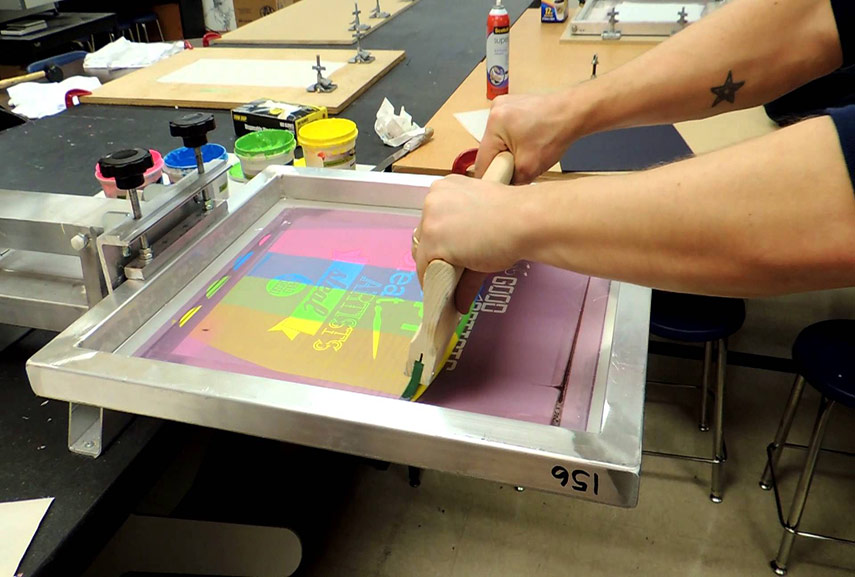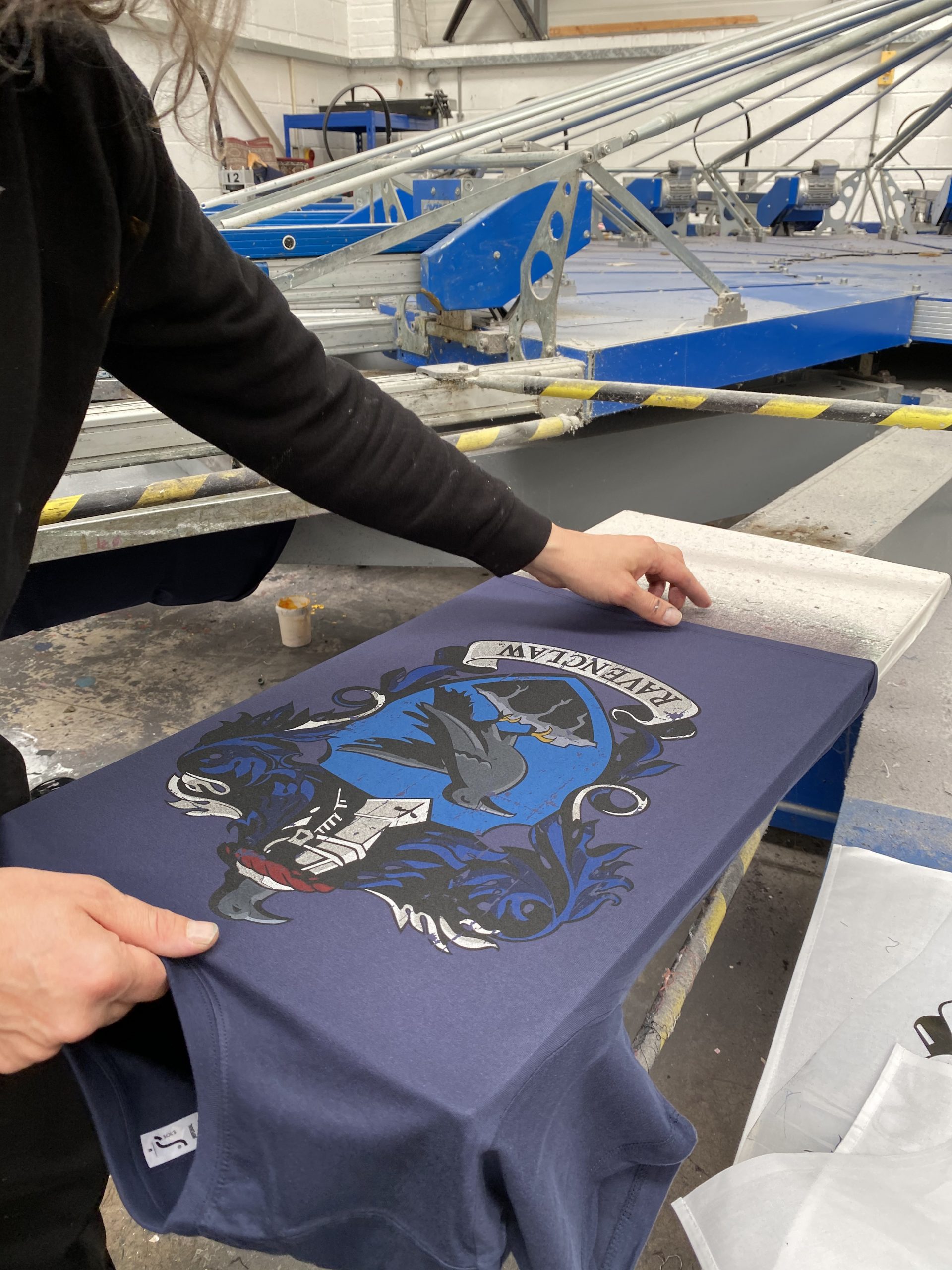ChatGPT said: How to get quick answers through 10:9 Design contact for your next order
Discover the Different Kinds Of Screen Printing Techniques for Your Next Job
Screen printing uses a diverse variety of techniques that can improve any creative job. From typical techniques like serigraphy to modern-day advancements such as direct-to-garment printing, each method has its special advantages. Specialized choices, including metal and green inks, introduce a lot more opportunities. Understanding these methods can considerably impact the final result. The difficulty exists in selecting the most ideal approach for specific needs and preferred results. What variables should one think about?

The Essentials of Screen Printing
Although screen printing might appear complex, it is basically a straightforward process that entails transferring ink with a mesh screen onto various surfaces. The technique begins with the creation of a pattern, which defines the design to be published. This stencil is connected to a mesh screen, typically made of polyester or nylon. Once the pattern is in location, ink is put on the screen and pressed with the mesh making use of a squeegee, resulting in the wanted pattern being printed on the underlying product.
Screen printing can be performed on a large range of substratums, including plastic, fabric, and paper, making it a functional option for various jobs. The process permits lively colors and intricate layouts, making it prominent in sectors such as art, fashion, and advertising and marketing. Recognizing these fundamentals gears up individuals with the foundational understanding needed to check out even more innovative methods in screen printing.
Conventional Screen Printing Techniques
Traditional screen printing methods have actually been utilized for centuries, preserving the workmanship and artistry of this technique. This method utilizes a mesh screen to move ink onto a substratum, such as material or paper, permitting vibrant and long-lasting layouts. The process begins with producing a pattern, which obstructs particular locations of the screen to manage where the ink will certainly be used.
One preferred strategy is serigraphy, typically used for minimal versions and creative prints. Another is using water-based inks, which are environment-friendly and provide a soft feel on textiles - 10:9 Design Texas. In addition, conventional approaches can include hand-operated printing, where craftsmens use ink with a squeegee, making sure precision and focus to information
These methods continue to be valued in the industry for their tactile high quality and the one-of-a-kind appearances they produce, appealing to both customers and creators that appreciate the heritage of screen printing.
Digital Screen Printing Innovations
As the demand for faster manufacturing and customization in the printing market has surged, electronic screen printing advancements have arised as a game-changer. This technology mixes typical screen printing approaches with electronic processes, permitting quick prototyping and detailed styles that were formerly challenging to attain. One significant advancement is the intro of direct-to-garment (DTG) printing, which assists in high-grade, full-color prints on numerous textiles without the requirement for screens. Additionally, improvements in ink formulas have led to environment-friendly alternatives that keep dynamic shades while reducing environmental influence. The usage of automated systems even more simplifies production, reducing labor costs and enhancing accuracy. These technologies not just satisfy little batch orders and customized styles yet also enable quicker turn-around times, making them suitable for companies concentrated on meeting client needs in a hectic market. Digital screen printing, as a result, stands for a vital development in the domain name of printing methods.
Specialized Screen Printing Approaches
Discovering specialized screen printing approaches reveals a diverse selection of methods that push the limits of imagination and performance in the printing market. Among these, glow-in-the-dark inks supply an one-of-a-kind visual effect, making designs come active in low-light conditions. Metal inks, understood for their glittering finish, include a touch of high-end to printed products. An additional ingenious approach is discharge printing, which removes color from the textile rather than adding ink, leading to a soft, classic feeling. High-density printing creates a raised structure externally, boosting responsive interaction. Furthermore, water-based inks are getting appeal for their vibrant colors and minimized environmental effect. Each of these specialized techniques satisfies certain layout demands, enabling brands and musicians to develop standout products that resonate with their target markets. By leveraging these approaches, businesses can elevate their screen printing tasks to brand-new elevations, ensuring unforgettable impacts.
Eco-Friendly Screen Printing Options
Eco-friendly screen printing alternatives are gaining grip as the market shifts towards sustainability. Sustainable ink selections and the usage of biodegradable materials are vital parts in minimizing the ecological impact of the printing process. By embracing these methods, screen printers you could try these out can contribute to an extra lasting future while maintaining top quality outcomes.
Sustainable Ink Selections

Biodegradable Products Usage
As the screen printing market develops, the unification of naturally degradable materials is coming to be progressively important for eco mindful methods. Designers and manufacturers are currently discovering inks and substrates made from all-natural, renewable energies that decompose extra effectively than standard counterparts. These biodegradable options reduce plastic waste and lessen ecological effect, straightening with the expanding demand for sustainable items.
Common examples include water-based inks and natural cotton textiles, both of which lessen dangerous chemicals and promote eco-friendliness. Brand names that take on these materials typically boost their market charm, bring in consumers who focus on sustainability. As understanding of environmental problems proceeds to climb, the change towards biodegradable materials in screen printing is most likely to get energy, cultivating a greener market standard.
Choosing the Right Strategy for Your Job
Just how can one figure out one of the most ideal screen printing technique for a particular project? The choice depends upon numerous aspects, including the material to be printed on, the complexity of the layout, and the desired manufacturing volume - 10:9 Design reviews. Direct-to-garment printing is optimal for detailed styles with countless colors, while traditional screen printing succeeds for larger runs of simpler graphics.
Additionally, consideration of the end-use of the published thing is vital. For outside applications, methods that supply resilience and weather resistance, such as plastisol ink, may be preferred. Conversely, environmentally-conscious jobs might take advantage of water-based inks or naturally degradable products.
Inevitably, comprehending the task's one-of-a-kind needs enables for an informed choice, guaranteeing both aesthetic allure and practical longevity. By evaluating design complexity, product compatibility, and manufacturing scale, one can efficiently select the most appropriate screen printing method to meet their task's goals.
Regularly Asked Questions
What Is the History of Screen Printing?
Screen printing stemmed in ancient China around 1000 AD, advancing with Japan and Europe. By the 20th century, it became preferred in commercial art and fashion, changing how styles were created and dispersed internationally.

Exactly how Do I Prepare Art Work for Screen Printing?
To prepare art work for screen printing, one should ensure high resolution, utilize a suitable color mode, produce different layers for each and every color, and transform message to lays out, assuring compatibility with the printing process and desired outcome.
What Products Are Ideal for Screen Printing?
The very best materials for screen printing consist of premium inks, resilient displays, and ideal substratums like cotton, polyester, or blends. Furthermore, using proper emulsion and squeegees can boost the printing procedure and results.
Can I Evaluate Print at Home?
Yes, screen printing in your home is feasible. With the right products, arrangement, and methods, people can create top notch prints. Mindful consideration of work space and devices is vital for successful outcomes.
What Are Typical Errors in Screen Printing?
Usual blunders in screen check here printing consist of incorrect direct exposure times, insufficient ink consistency, misalignment of screens, not enough cleaning of materials, and neglecting to examine prints. These mistakes can jeopardize the top quality and precision of the end product.
Screen printing may appear complicated, it is fundamentally a simple process that includes transferring ink with a mesh screen onto different surfaces. As the need for faster production and customization in the printing industry has actually risen, electronic screen printing developments have emerged as a game-changer. Discovering specialty screen printing techniques reveals a diverse range of methods that press the limits of creative thinking and functionality in the printing market. The finest materials for screen printing include high-grade inks, long lasting displays, and appropriate substratums like cotton, polyester, or blends (10:9 Design reviews). Common mistakes in screen printing include inappropriate exposure times, poor ink uniformity, misalignment of screens, insufficient cleaning of products, and published here overlooking to evaluate prints